Q&A – Ask Neil: June 8, 2023
(Please read these instructions carefully.)
Before you post your question, please look at recent issues to see if someone else has already asked it. You might find your answer there.
How to submit your question…
• Click the link provided below to post your question. After you submit your question, a new window will pop up giving you the address to which you can e-mail a sharp, high-resolution photo to accompany your question. Please do not send thumbnail photos in case I need to zoom in to see things.
• Click here to post your question.
• Please only post your question one time. We can only accept a set number of questions each week, and when we get duplicates it costs other people their chances.
• One question per reader, please.
• Please use this only for posting questions – not for standard emails.
• Watch for your answer in the following week’s e-gardens.
• I choose those of greatest general interest. For example, plant IDs seldom make the cut.
• I must have your first name or initials.
• I must have your city or county. (Texas is a very large state.)
QUESTION 1
WHAT HAPPENED TO MY HOLLY FERNS?
Question: What happened to my holly ferns? Last year they were so beautiful, but this year some of them have come back to life and some have not. Some have only tiny sprouts visible. Olga Geyfman-Orlova, Dallas, but in Collin County.
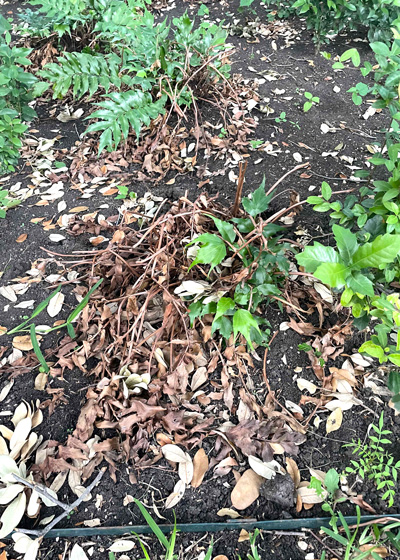
Answer: They froze. That Christmas 2022 freeze, an extreme one, zapped many of them. I live in rural Collin County and I have my holly ferns against a warm wall. Even then, I cover them with frost cloth any time the temperatures are going to drop into the teens. We went well into single digits this past winter. Have frost cloth cut and ready to put down over your plants if you opt to replace the missing ones with more holly ferns. They just aren’t quite winter-hardy enough for our area.
QUESTION 2
WHAT ARE THE BEST DEER-RESISTANT SHRUBS OR SMALL TREES?
Question: Can you recommend shrubs or small trees that are deer-resistant that I can plant beside Grandson Baelon’s grave? Pat S., Brady.
Answer: I would be honored to give it my best, and that’s going to be to refer you to this list from Forrest Appleton. He is both a Bexar County (similar conditions to Brady) Master Gardener and a Retired Certified Nursery Professional. He has worked alongside my friend Dr. Jerry Parsons on many of Jerry’s outstanding horticultural research efforts. Forrest has the best list of deer-resistant plants that I’ve seen.
Here is the link to Forrest’s research on Dr. Parsons’ Plant Answers website:
https://aggie-hort.tamu.edu/plantanswers/publications/deerbest.html
Note: As I give you this link it is still active. I saw something that made me think that TAMU is redoing big parts of their website. I fear that we may lose extremely valuable information like this. Oh, good heavens, I hope not. You might print in hard-copy this just in case.
QUESTION 3
DO YOU HAVE A YEAR’S CALENDAR FOR LAWN PRODUCT APPLICATIONS?
Question: Would you have a year calendar for when weed preventive treatments, fertilizer, grub and other insect treatments and other yearly products should be applied for St. Augustine lawns? What month do all the different products get put down? Edie Miller, Grapevine.
Answer: Without wanting to sound like an ad for my book, I have an entire chapter – 48 pages, 4 pages per month, of what needs to be Planted, Pruned, Fertilized, and Protected for each of the 12 months. That’s Chapter 2 of the book you see advertised here in e-gardens. Add to that the entire chapter on just Lawns alone. I spent one month on each of those chapters, so it would be impossible to recreate them in any detail in this form of answer. As always, you have my complete guarantee of total satisfaction of full refund when you buy the book from me. (It is not in stores or on Amazon.) Take a look at the book here at my website.
QUESTION 4
WHY FEW IRIS BLOOMS IN TARRANT COUNTY THIS SPRING?
Question: My iris varieties usually have many spring blooms, but not this year. I asked a number of other Tarrant County gardeners about theirs, and most responded that they, too, had few flowers. Was this just in Tarrant County? What would have caused it? Margaret S., Fort Worth.
Answer: I noticed the same thing around North Texas. That was true for several other species of spring-flowering plants. I just chalked it up to the extreme cold around Christmas. It threw things off schedule. Assuming you’re taking good care of your iris they should be back to normal by next year.
QUESTION 5
IS THIS CHINQUAPIN OAK HEALTHY?
Question: Our Chinquapin oak shades a bench that our neighborhood uses. This year the tree does not look healthy. I sent the photos to an arborist. He told me this species could take a lot of stress, but if it presents any hazard I want to take it down. Denise R., Little Elm.
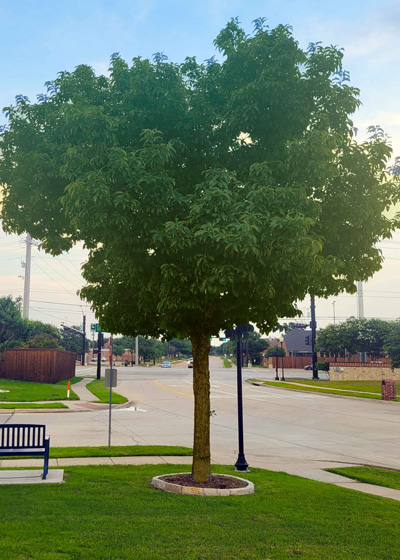
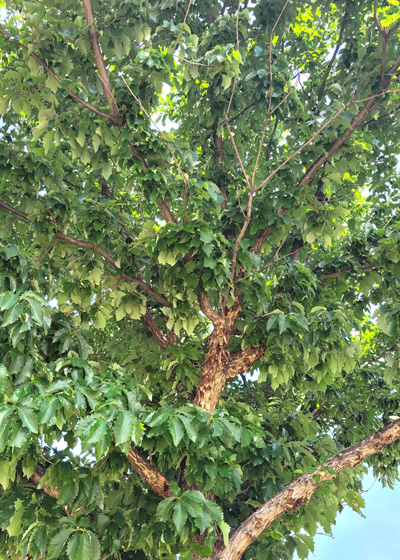
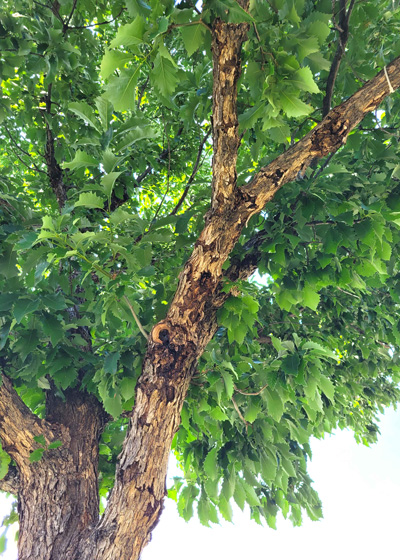
Answer: Chinquapin oaks are outstanding native shade trees. I have a handsome one that I planted 30 years ago along our driveway, and I’ve enjoyed watching it grow toward maturity. I will admit that there is something about the growth patterns of your tree’s bark that is unusual, but the leaves look very normal. I had to brighten the overall photo of the tree a good bit in Photoshop to be able to see things. (The sun was apparently on the other side of the tree when you photographed it.) I do see some dead and dying branches in the top of the tree. You should visually follow those down onto the main trunk to see if there is any clue as to what problem might exist. Otherwise, I would suggest you have a certified arborist look at this tree and perhaps watch it for a year or two. It presents no risk to anyone at this time. The tree’s canopy is essentially very healthy except for the things that I’ve noted. It may just be developing burls along that branch.
QUESTION 6
WHY ARE MY TOMATOES NOT GETTING RIPE YET?
Question: Normally my tomatoes are getting ripe by this time of year, but not this year. Why would that be? Jodie, Coppell in Dallas County.
Answer: There could be several reasons. I know I’m going to sound like I’m dodging your question, but are they the same variety you normally grow? Did you plant them at roughly the same date and in the same place (sunlight)? Have you cared for them the same as always (water and fertilizer)? My guess, living within 40 miles of you, would be that the fairly cool weather we’ve had might have had something to do with it.
QUESTION 7
WHAT SHOULD I DO WITH MY CRAPE MYRTLES
Question: What should I do with a crape myrtle that has no growth on its top but generous suckers coming up from the ground? The top appears dead. Willie S., Pearland.
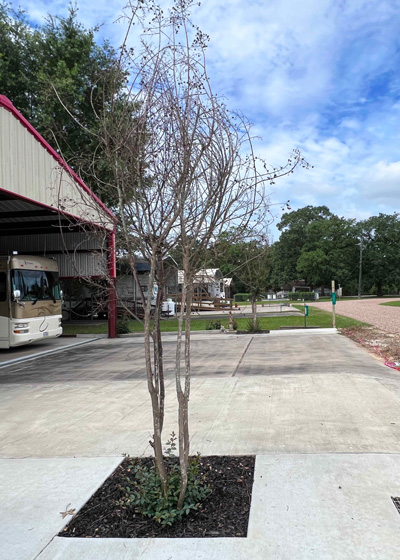
Answer: Cut the dead top growth completely back to the new shoots, generally within an inch or so of the ground. Given an all-nitrogen fertilizer every six weeks during the summer the new shoots should develop very rapidly. Here is information we have on our Crape Myrtle Trails of McKinney website about how to retrain a damaged plant. Scroll to the bottom of that page. I’m sure the Christmas cold spell killed it back. As far south as you are, that will probably never happen again once the plant is established.
QUESTION 8
WHY DOES MY BERMUDA LOOK DIFFERENT?
Question: Some parts of my bermuda lawn always look lighter green than others. They also thin out and start to die. It happened in 2022 and I can already see it happening again. I used an all-nitrogen fertilizer on April 15. What should I do? Chia Liao, Little Elm.
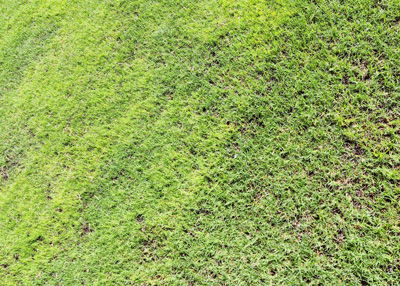
Answer: There seems to be a distinct demarcation between the two areas – almost a straight line. For that reason, my best estimate is that you may have two different types of bermudagrass in your lawn. That can happen when a delivery arrives and the grass comes off two different pallets. It looks like you have a coarser grass on the right and a finer textured grass on the left. Put in other terms, you might have a type of bermuda bred for fairways and intended to be mowed somewhat higher (say 3/4-in.) on the right and a golf green grass intended to be mowed at the lowest height (perhaps lower than 1/4-in.) on the left. When you mow bermudas at heights different from their optimal heights they usually look different and less attractive.
Leaving that thinking aside, if there are differences that are not varietal, it could be due to soil types. Sometimes builders aren’t careful in how they do their final grading and sand can be left in one area, clay in another.
You’ve waited two months since the last feeding. That’s too long for these dwarf bermudas. You need to fertilize them more often, but with less fertilizer applied at a time.
Without more information or a clearer photo, that’s the best I can do.
QUESTION 9
HOW CAN I PREPARE FOR A HOTTER-THAN-NORMAL SUMMER?
Question: How can I prepare for a hotter-than-normal summer due to El Niño? Susan H., Frisco.
Answer: My buddies Siri and Pete Delkus from Channel 8 WFAA both tell me that El Niños bring us cooler-than-normal summer weather and that we are to expect an El Niño summer this year. Honestly, I don’t sit around worrying about what I can do to prepare for the extra degree or two one way or the other (or the extra inch of two of rainfall one way or the other). I just take what comes and deal with it. I have enough problems that are right here in front of me already.
QUESTION 10
WHY IS BARK COMING OFF THE TRUNK OF MY JAPANESE MAPLE?
Question: Bark has started coming off the trunk of my Japanese maple within the past several weeks. There are also small vertical cracks. The tree is on the northeast side of the house. What should I do? David Y., Rowlett.

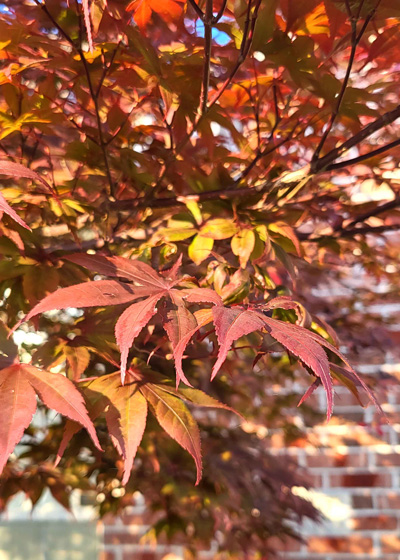
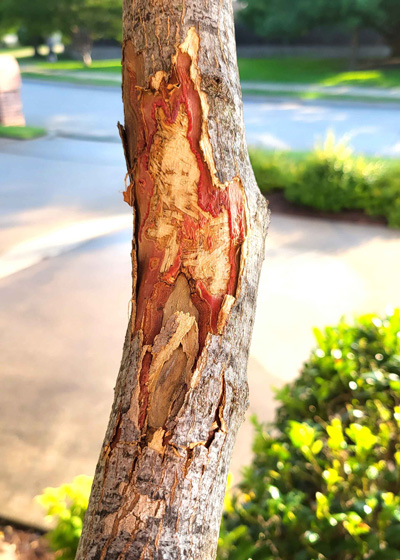
Answer: I know you said this is on the northeast side your house, but it looks like the trunk of your tree is getting a good bit of sunlight. Sunscald is a real issue for maples, oaks and Chinese pistachios, and this is exactly how it appears as it’s unfolding. Are these spots where the bark is missing on the sunniest side of the trunk? If so, that’s the cause, and until the tree is able to shade itself there isn’t much you can do to correct damage that has already been done. Applying paper tree wrap when the tree was younger would have helped, but then again, Japanese maples do much better when they aren’t exposed to sunlight in the first place. Their leaves scorch badly.
As for your photo of the leaves changing from purplish-red to reddish-tan, that’s somewhat normal for many of the red-leafed Japanese maples. They just don’t hold their color well in our intense heat. Growing it in part sun speeds that color shift along. The variety Bloodgood holds its color better than most.
QUESTION 11
CAN YOU HELP WITH GROWING EDAMAME?
Question: Can you help me with growing edamame here? Something has eaten my plants, plus any other details you can provide. Jodi, College Station.
Answer: Jodi called my statewide Texas Lawn and Garden Hour last weekend with questions about growing edamame in her home garden. I told her I was a much better consumer of edamame than I was an educator on its culture. But I assured her I would do my homework and that I would provide an answer here.
As most readers may know, edamame is merely a different type of soybean grown for fresh consumption as a snack or vegetable. Many of us have found it to be very good when we dine out.
I did 40 minutes of online searching, and the best information I came across is from Utah State University. I couldn’t find much from any of the southern universities. This one really did sum things up best.
In the meantime, Jodi has written back to let us know that following one of those heavy late spring rains this week she went out to her garden and came across footprints of the culprits who have been devouring her own edamame plants: deer. So, at least we have that one question answered. I hope this bulletin will fill in the additional voids.
https://extension.usu.edu/archive/what-is-edamame-and-should-i-grow-it
